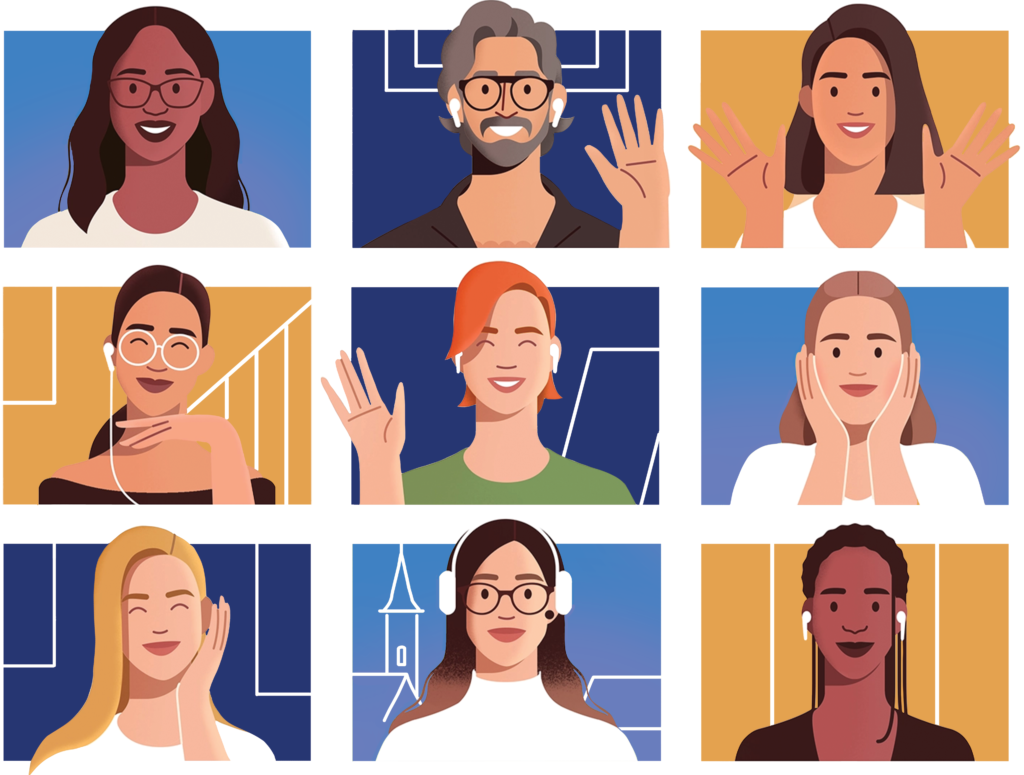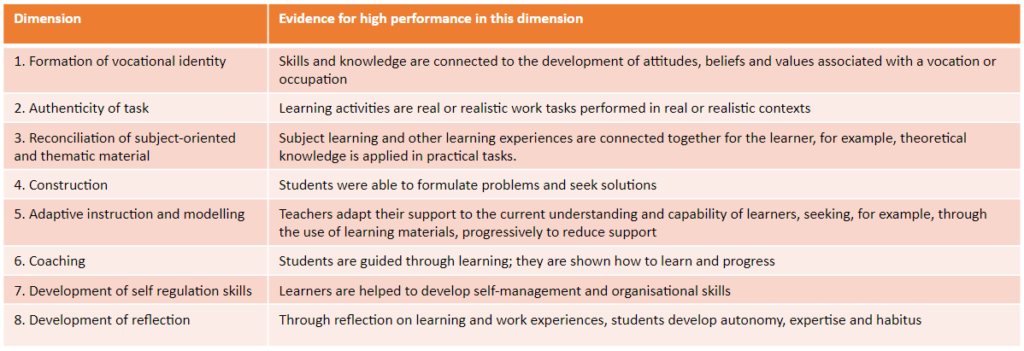
The inclusive educator
The inclusive educator
This module outlines the characteristics and behaviour of teachers and educators considered to be inclusive, encouraging of students with diverse backgrounds reaching their personal best.

This module outlines the characteristics and behaviour of teachers and educators considered to be inclusive, encouraging of students with diverse backgrounds reaching their personal best.

Aim & Learning Outcomes
Key concepts, background information, relevant theories
Exercises, self-reflection & practical resources to promote inclusive e-learning
Advice, ideas and proposals on relevant issues
References and further reading
A module outlining the characteristics and behaviour of teachers/educators considered to be inclusive, encouraging of students with diverse backgrounds reaching their personal best
After the completion of this module, learners (VET teachers/trainers/educators and also VET providers/Staff, as well as other key actors of educational sector) will be able to:

This modules demonstrates the benefits of three different units:
1.Understanding inclusive education
2. Profile of inclusive educators
3. Addressing students’ learning styles and needs

Or maybe you have chosen other instruments such as the piano or even a giant harp! You might have also decided to include electronic instruments and guitars for performing some modern compositions!
Is there anyone who imagined an orchestra consisting solely by one musical instrument? For example, an orchestra composed exclusively by 50 or more cellos or violins? How does this sound to you? The result could still be impressive, however there would be a variety of amazing things that this homogenous group simply wouldn’t be able to perform! There would be so much music that they’d be unable to play!
Are you seeing the analogy with diversity and inclusion in your class? Yes, you are an educator but also a music conductor who recognizes the importance and unique involvement of every student who will contribute as a sole musical instrument to the final orchestral result!
Your classroom, whether in-person, online or hybrid, is your orchestra! ….Would you ever ask a violin to sound like a piano?! Or a guitar to play like a trumpet?!
Self reflect or discuss with others some lessons we can learn from an orchestra (Robertson, 2019) when it comes to achieving a diverse and inclusive classroom.
Inclusive education is the first principle of the European Pillar of social rights which underlines that: “Everyone has the right to quality and inclusive education, training and life-long learning in order to maintain and acquire skills that enable them to participate fully in society and manage successfully transitions in the labour market” (European Commission, European Education Area).
Inclusive education means real learning opportunities for groups who have traditionally been excluded. Inclusive educational systems value the unique contributions that students of all backgrounds bring to the classroom and allow diverse groups to learn and grow side by side, to the benefit of all (UNICEF)
The main relation of VET and inclusion can be mostly seen as VET being a vehicle for social inclusion – via enabling people to successfully enter the labour market.

Do some further research on your own, self-reflect and/or discuss it with other people and give your own definition of inclusive (VET) education.
Tips:
Diversity is present in every classroom. If you ignore it and you are not working towards inclusive education, you’re not doing your job as you should…! Consider the following three reasons provided by the Prodigy Education website about the importance of diversity in the classroom.
In the context of the DESTINE project, the term VET educator refers both to VET teachers and trainers, while sometimes the two terms might be used interchangeable.
However, it is useful to know what the European Centre for the Development of Vocational Training (CEDEFOP, 2022) mentions:
Think for a moment your current or previous classes. Could your group be considered diverse because of one or more of the following?
Think also if you had students who had different levels of motivation, attitudes, academic or working experience or different responses to specific classroom environments and instructional practices.
In a diverse but yet inclusive classroom, whether physical or virtual, effective teaching means the work of effective educators. But who is actually the effective inclusive teacher/trainer?
Effective inclusive educators focus not only in things such as lesson clarity, instructional variety, engagement in the learning process and student success rate, but also –and this is a critical point– in the inclusion of students from various backgrounds, with mixed needs and mixed abilities.
Remember the orchestra analogy in unit 4.1: Effective inclusive educators are talented and hardworking music conductors who achieve to build an orchestra composed by motivated musicians playing various instruments, creating all together great pieces of music!
The European Agency for Development in Special Needs Education has identified in the context of the “Teacher Education for Inclusion (TE4I project) four core values relating to teaching and learning as the basis for the work of all teachers in inclusive education. To learn more about these values, match correctly the following columns [matching exercise].
In this section we summarize these core values along with the associated areas of teacher competence, that are made up of three elements: attitudes, knowledge and skills. A certain attitude or belief demands certain knowledge or level of understanding and then skills in order to implement this knowledge in a practical situation.
For a detailed presentation/analysis you are advised to check the relevant source: European Agency for Development in Special Needs Education (2012). Teacher Education for Inclusion (TE4I project): Profile of Inclusive Teachers.

In addition, the inclusive (VET) educator:
For a teacher who teaches in an inclusive way, inclusion is not “just tolerance”, but unquestioned acceptance. And this is exactly a key-point that inclusive educators should try to instill to their classroom.
When we are children, we are usually taught that, if something is wrong, we ought to avoid that thing, or take action to stop it (e.g. Plastic in the oceans? Use less plastic! And join the campaign against plastic!). The idea that sometimes we should not only stand back and allow some behaviour, but should also behave in a welcoming manner towards the person responsible for that behaviour, is hard to understand.
After all, if you believe something is morally wrong, why wouldn’t you intervene to stop it?! As Easton (2021) points out: “The usual justifications that crop up to answer this question – pragmatic justifications about social cohesion, epistemological justifications based on the difficulty of answering certain types of questions, or (most powerful, in my view) moral justifications based on the need to respect people’s autonomously arrived-at decisions – need to be carefully explained and discussed if we are to avoid children moving, forgivably, from tolerance to relativism (the view that there is no right or wrong when it comes to moral questions)”.
In an inclusive learning environment the tolerant person is a non-judgmental person, disinclined to disapprove of ways of life that differ from their own, and even appreciating their value and worth. This is an understanding of tolerance as more of a positive, “open-minded” attitude. Quoting Easton (2021) “Whereas tolerance as forbearance implies that a racist who refrains from acting on their racist beliefs is being tolerant, tolerance as non-disapproval implies that the tolerant person wouldn’t hold racist beliefs in the first place”.
*Do you respect the diversity of your class?
*Do you enable all students to take part in learning and fulfil their potential?
*Do you ensure that different students’ learning needs and preferences are met, regardless of their backgrounds, learning styles or abilities?
*Do you remove any barriers that prevent students from learning?

No, everyone learns differently! We all have different ways of experiencing the world, and as a result, different learning styles exist. Understanding these various learning styles can have a significant impact on how educators interact with their students, organize group projects, and modify individual learning.
Generally speaking, these are the most common types of learners (Malvik, 2020).
Learning styles and preferences can take many forms, and not everyone fits neatly into one and only category.



Tips:
Digital inclusive teaching and learning nowadays
Since both teaching and learning have undergone significant change the last 20 years and especially during the COVID-era, it is highly likely that VET educators who finished their education ten or more years ago will find themselves in a different learning environment than they did when they were students themselves. Adult education has become lifelong learning; students are more often mentioned as learners, teachers are facilitators of learning; schools are now learning environments; while learning outcomes are carefully monitored (Smith 1999/2020).
Your perceptions of the learning process have impact on your teaching style and methods! Contrary to what one might think, we do not all share the same conception of the learning process. Among those who have studied the issue, is the Swedish educational psychologist and researcher Roger Säljö (1979), who conducted a survey among people with very different learning experiences and defined five different conceptions of the learning process.
In the following years, various others studies explored the conceptions of learning in different audiences identifying even more conceptions of learning, e.g. learning as personal fulfillment, as changing as a person, as a duty, as a process not bound by time or context or as developing social competence (Purdie & Hattie, 2002).
Fill the blanks with the correct given words to figure out what “learner-centred Pedagogy” is, focusing on VET, according to Bremner, Sakata & Cameron (2022) and Cedefop (2015). [Gap filling exercise]

Source: Bremner, Sakata & Cameron, 2022, adapted from Bremner, 2021
In addition, Cedefop’s learner survey (2015) revealed the characteristics of teaching or learning that were significantly associated with higher levels of attentiveness or motivation. These characteristics have been grouped together according to which of the eight pedagogical dimensions of the theoretical model they correspond to.

Source: Cedefop, 2015, adapted from de Bruijn and Leeman, 2011

Source: Cedefop, 2015, learner survey
In the (post)COVID age of digital literacies, VET educators are no longer “experts,” but rather co-creators of knowledge with their students, mentors and coaches. As a result, classroom activities are fundamentally different, theory is infused in practice, and the goal is to produce “new activities on new media” and re-establish the teacher-student relationship, also helping students to create stronger bonds with their co-students and gain a more inclusive view of the world.
The availability of Open Educational Resources (OER) can “change the nature of the teaching activity itself, with self-directed learners able to take more control over their learning” (European Commission, 2012, p. 22). However, since not all students know how to use the whole range of new technologies or don’t have good navigation skills, the key for educators is to help them how to identify, search, evaluate, analyse and use in an effective way the huge amount of data and information that surrounds us in the digital era.
Being an inclusive educator in a “digital literacies”, (post)pandemic environment means to be a lifelong learner!
This activity will help educators challenge stereotypes, including their own, and reflect on their role as teachers/trainers in building and maintaining an inclusive learning environment. It can be conducted either as self-directed or guided learning activity under the guidance of a trainers’ trainer.
Self-reflect to think of a situation where you had a stereotype assumption about a student that proved to be inaccurate. If you are a trainers’ trainer ask participants to self-reflect and then ask from volunteers to share their incidents/thoughts.
Watch the “All that we share” video created by the Danish Channel TV2
Answer the questions (If you are a trainers’ trainer ask participants to self-reflect and then ask from volunteers to share their incidents/thoughts):
Watch the Always #LikeAGirl video.
Answer the questions (If you are a trainers’ trainer ask participants to self-reflect and then ask from volunteers to share their incidents/thoughts):
Self-reflect (or discuss with the group) on the role of educator in building and maintaining an inclusive learning environment, based on what you have learned in Module 4 and in general in the DESTINE course, so far.
This activity explores dynamics in the classroom, helping teachers and trainers to improve the ways they exercise their power in various ways. It can be conducted either as self-directed or guided learning under the guidance of a trainers’ trainer.
Read the five scenarios that follow and in each case imagine and describe the climate in the classroom.
Complete the matching exercise to find out to which type of power each scenario refers to.
Self-reflect or discuss about the types of power that you practice in your classroom
Think or even write a short paragraph about how these various types of power can be combined so as to achieve the best possible results in the classroom and empower students.
Read the “Conclusion – ‘food for thought’ section” or –if you are a trainers’ trainer, conduct a dialogue to wrap up the activity.
(Optional) You can read the relevant sources (Teaching Times, 2021; Flaherty, 2018; Thomas, 2014)
Teacher tells students what to do such as assigning homework and generally students accepts this assignment through –more or less– respect for the status of the teachers’ position. Students believe that the teacher has the right to prescribe behavior given the status of their position.
The teacher practices continuous and exhaustive monitoring and emphasizes compliance rather than cooperation. Students believe that their teacher possesses the ability to punish or refrain from punishing. Students might rebel, lie, cheat or even withdraw from learning.
The teacher introduces stimulants that students perceive to be pleasant such as recognition and privileges as well as removing stimulants that students perceive to be unpleasant. Students believe that the teacher possesses the ability to distribute or withhold rewards not obtainable elsewhere.
The teacher is fair and concerned about students. Not only does he/she has the expertise but also shows warmth and care. The teacher provides beneficial feedback, talks with students about matters outside of VET school, and has high expectations for all. Students desire to be liked by their teacher and those who feel in a less powerful position, bid to emulate the personal characteristics of their teacher.
Teacher brings knowledge and experience into the classroom. He/she not only knows their teaching subject but can also express it in a way that is confident and clear to the students, bringing positive energy into the learning environment through the joy of teaching. Teacher is a leader and a mentor and students acknowledge his/her authority and believe that their teacher’s expertise is important for achieving the tasks they are presented with.
As Thomas (2014) puts it in a nutshell:
This is a long-term activity that aims to guide educators on how to apply inclusive teaching strategies and build strong relationships with their students.
Self-reflect and then ask from volunteers to share their incidents/thoughts.
2. Read the following and then think and make a list of practical tips that fall under the two proposed strategies and can facilitate educators to create a welcoming classroom for all:
Yale University – Poorvu Center for Teaching and Learning (2017) separates inclusive teaching strategies into two categories:
3. Explore the variety of examples and strategies presented in the “Useful Tips” section of this module for
mastering inclusive teaching pedagogy.
4. Evaluate the methods and tools that you use in your classes.
5. What are you planning to do from now on, so as to build a better inclusive strategy for a safe and welcoming
class for all?
Based on Wyatt-Ross (2018) and Yale University – Poorvu Center for Teaching and Learning (2017), we have adapted and propose (in random order) various relationship-building approaches that can help educators -both in physical and online classes- to build a welcoming and safe classroom for all:
Diversity, inclusion and the sense of belonging is a vital part of students’ experience.
It is YOU, who as a VET teacher/trainer are the key-element in the creation of an inclusive classroom, whether physical, online or hybrid!
Realize the “super power” that you have to create a classroom where all students feel welcome and safe to be themselves and take action!
You are not alone in this effort! There are strategies, methods, tips and people who can help you! Attending the DESTINE course proves that you are on the right path!
▸Bremner, N. (2021). The multiple meanings of ‘student-centred’ or ‘learner-centred’ education, and the case for a more flexible approach to defining it, Comparative Education, 57:2, 159-186, DOI: 10.1080/03050068.2020.1805863
▸Bremner, N., N. Sakata & L. Cameron (2022) The outcomes of learner-centred pedagogy: A systematic review. International
Journal of Educational Development, Vol. 94, 2022, 102649.https://doi.org/10.1016/j.ijedudev.2022.102649.
▸Bruijn, E. de; Leeman, Y. (2011). Authentic and self-directed learning in vocational education: challenges to vocational educators.
Teaching and teacher education, Vol. 27, Issue 4, pp. 694-702.
▸Cedefop (2015). Vocational pedagogies and benefits for learners: practices and challenges in Europe. Luxembourg: Publications
Office of the European Union. Cedefop research paper; No 47. https://www.cedefop.europa.eu/files/5547_en.pdf &
https://www.cedefop.europa.eu/en/publications/5547
▸Cedefop (n.d.). Inclusive environment.
https://www.cedefop.europa.eu/en/tools/vet-toolkit-tackling-early-leaving/protective-factors/inclusive-environment
▸CEDEFOP/European Centre for the Development of Vocational Training (2022). intervention approach on “Professional
development for inclusive teaching and training”.
https://www.cedefop.europa.eu/en/tools/vet-toolkit-tackling-early-leaving/intervention-approaches/professional-development-
inclusive-teaching-and-training
▸Easton, C. (2021). Teaching tolerance in schools cannot avoid controversy. Support Psyche
https://psyche.co/ideas/teaching-tolerance-in-schools-cannot-avoid-controversy
▸EENET/Enabling Education Network, UK (n.d). Inclusive education.
https://www.eenet.org.uk/what-is-inclusive-education/defining-inclusive-education
▸European Agency for Development in Special Needs Education (2012). Teacher Education for Inclusion (TE4I project): Profile of Inclusive
Teachers. Odense, Denmark: European Agency for Development in Special Needs Education.
https://www.european-agency.org/sites/default/files/Profile-of-Inclusive-Teachers.pdf (EN). Available in multiple languages in
https://www.european-agency.org/resources/publications/TPL4I-profile
▸European Commission (2012). Rethinking education, investing in skills for better socioeconomic outcome: communication from the
Commission to the European Parliament, the Council, the European Economic and Social Committee and the Committee of the Regions.
COM(2012) 669 final. https://eur-lex.europa.eu/legal-content/EN/TXT/PDF/?uri=CELEX:52012DC0669&rid=1
▸European Commission, European Education Area (n.d.). Inclusive education.
https://education.ec.europa.eu/focus-topics/improving-quality/inclusive-education
▸Flaherty, A. (2018). Power and Empowerment in Schools. Contemporary Pedagogies in Teacher Education and Development. doi:
10.5772/intechopen.76483 https://www.intechopen.com/chapters/60901
▸Malvik, C. (2020). 4 Types of Learning Styles: How to Accommodate a Diverse Group of Students. Rasmussen University.
https://www.rasmussen.edu/degrees/education/blog/types-of-learning-styles
▸Purdie, N., J., Hattie (2002) “Assessing Students’ Conceptions of Learning”, Australian Journal of Educational & Developmental
Psychology. Vol 2, p.p. 17-32. https://core.ac.uk/download/pdf/10881606.pdf
▸Robertson, A. (2019, 6 July). Building an Orchestra: Lessons on Diversity and Inclusion. LinkedIn
https://www.linkedin.com/pulse/building-orchestra-lessons-diversity-inclusion-from-alexis-robertson
▸Säljö, R (1979) “Learning about learning”, High Educ Vol(8), p.p. 443–451. Available at https://doi.org/10.1007/BF01680533.
▸Smith, M. K. (1999-2020) “Learning theory”, The encyclopedia of pedagogy and informal education. Available at
https://infed.org/mobi/learning-theory-models-product-and-process.
▸Teaching Times (2021). How power dynamics influence learning. https://www.teachingtimes.com/slt81-power-dynamics
▸Thomas, D. (2014). Power in the Classroom. LinkedIn.
https://www.linkedin.com/pulse/20140609082714-324997647-power-in-the-classroom
▸Unesco (n.d.). Interview with the UNESCO-IBE Director, Clementina Acedo.
http://www.ibe.unesco.org/fileadmin/user_upload/-Policy_Dialogue/48th_ICE/Press_Kit/Interview_Clementina-_Eng13No
v.pdf
▸UNICEF, (n.d.). Inclusive education. https://www.unicef.org/education/inclusive-education
▸University College London/UCL (2019). Inclusive teaching. Teaching Toolkits.
https://www.ucl.ac.uk/teaching-learning/publications/2019/aug/inclusive-teaching
▸Wyatt-Ross, J. (2018). A Classroom Where Everyone Feels Welcome. Edutopia.
https://www.edutopia.org/article/classroom-where-everyone-feels-welcome
▸Yale University – Poorvu Center for Teaching and Learning (2017). Inclusive Teaching Strategies.
https://poorvucenter.yale.edu/InclusiveTeachingStrategies
▸Cedefop (2022, 26 May), “Making VET inclusive for Ukrainian refugee students” (blog article with links to useful resources). https://www.cedefop.europa.eu/en/blog-articles/making-vet-inclusive-ukrainian-refugee-students
▸Cedefop (n.d.), “Digital inclusion – Intervention Approach” (advice to policy makers and VET practitioners). https://www.cedefop.europa.eu/en/tools/vet-toolkit-tackling-early-leaving/intervention-approaches/digital-inclusion
▸Cedefop (n.d.), “Professional development for inclusive teaching and training – Intervention Approach” (advice to policy makers and VET practitioners). https://www.cedefop.europa.eu/en/tools/vet-toolkit-tackling-early-leaving/intervention-approaches/professional-development-inclusive-teaching-and-training
▸Cedefop (n.d.), “Psychosocial support – Intervention Approach”. https://www.cedefop.europa.eu/en/tools/vet-toolkit-tackling-early-leaving/intervention-approaches/psychosocial-support
▸Cedefop (n.d.), “Tailored learning pathways – Intervention Approach” (Advice to policy-makers and practitioners). https://www.cedefop.europa.eu/en/tools/vet-toolkit-tackling-early-leaving/intervention-approaches/tailored-learning-pathways
▸Cedefop (n.d.), Reflection Tool for VET providers & Evaluation plan for learning providers. https://www.cedefop.europa.eu/en/tools/vet-toolkit-tackling-early-leaving/evaluate/reflection-tool-for-vet-providers & https://www.cedefop.europa.eu/en/tools/vet-toolkit-tackling-early-leaving/evaluate/evaluation-plan-providers-practitioners
▸EPALE- Electronic Platform for Adult Learning in Europe. https://epale.ec.europa.eu/en
▸European Commission/Directorate-General for Education, Youth, Sport and Culture, ECORYS & EIESP (2021). Enhancing learning through digital tools and practices. How digital technology in compulsory education can help promote inclusion: final. https://op.europa.eu/en/publication-detail/-/publication/b12644c4-315c-11ec-bd8e-01aa75ed71a1/language-en
▸Gay & Lesbian Equality Network (2016). ‘BEING LGBT IN SCHOOL’ A Resource for Post-Primary Schools to Prevent Homophobic and Transphobic Bullying and Support LGBT Students. https://www.education.ie/en/publications/education-reports/being-lgbt-in-school.pdf
▸NERCHE/New England Resource Center for Higher Education: Self-Assessment Rubric for the Institutionalisation of Diversity, Equity, and Inclusion in Higher Education. College of Education and Human Development, University of Massachusetts Boston https://www.wpi.edu/sites/default/files/Project_-Inclusion_NERCHE_Rubric-Self-Assessment-2016.pdf
▸Pickering. J. (2015). “How to start using technology in your teaching”. Higher Education Academy. https://www.advance-he.ac.uk/knowledge-hub/how-start-using-technology-your-teaching
▸UK Government – Department of Education (2017). Preventing and tackling bullying Advice for headteachers, staff and governing bodies. https://assets.publishing.service.gov.uk/government/-uploads/system/uploads/attachment_data/file/623895/-Preventing_and_tackling_bullying_advice.pdf
▸UNESCO (2020). Policy paper 43: inclusive teaching: preparing all teachers to teach all students (available in English, Français, Español, العربية). https://en.unesco.org/gem-report/2020teachers
▸UNHCR (2021), “UNHCR Teaching About Refugees 2021 – Words matter Summary Table”. https://www.unhcr.org/6177f48c4
▸Xu, W. (2011). Learning Styles and Their Implications in Learning and Teaching. Theory and Practice in Language Studies. Vol. 1, No. 4, pp. 413-416, April 2011. https://www.academypublication.com/issues/-past/tpls/vol01/04/15.pdf
The European Commission’s support for the production of this publication does not constitute an endorsement of the contents, which reflect the views only of the authors, and the Commission cannot be held responsible for any use which may be made of the information contained therein
project number : 2021-1-FR01-KA220-VET-
